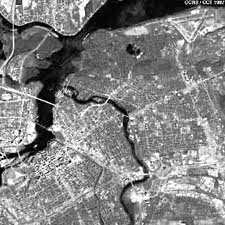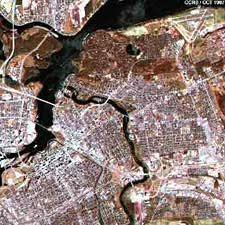
| Table of Contents |
1. Introduction |
|
2. Sensors 3. Microwaves 4. Image Analysis 5. Applications |
Fundamentals of Remote Sensing
1.7 Characteristics of Images
Before we go on to the next chapter, which looks in more detail at sensors and their characteristics, we need to define and understand a few fundamental terms and concepts associated with remote sensing images.
 Electromagnetic energy may be detected either photographically or electronically. The photographic process uses chemical reactions on the surface of light-sensitive film to detect and record energy variations. It is important to distinguish between the terms images and photographs in remote sensing. An image refers to any pictorial representation, regardless of what wavelengths or remote sensing device has been used to detect and record the electromagnetic energy. A photograph refers specifically to images that have been detected as well as recorded on photographic film. The black and white photo to the left, of part of the city of Ottawa, Canada was taken in the visible part of the spectrum. Photos are normally recorded over the wavelength range from 0.3 mm to 0.9 mm - the visible and reflected infrared. Based on these definitions, we can say that all photographs are images, but not all images are photographs. Therefore, unless we are talking specifically about an image recorded photographically, we use the term image.
Electromagnetic energy may be detected either photographically or electronically. The photographic process uses chemical reactions on the surface of light-sensitive film to detect and record energy variations. It is important to distinguish between the terms images and photographs in remote sensing. An image refers to any pictorial representation, regardless of what wavelengths or remote sensing device has been used to detect and record the electromagnetic energy. A photograph refers specifically to images that have been detected as well as recorded on photographic film. The black and white photo to the left, of part of the city of Ottawa, Canada was taken in the visible part of the spectrum. Photos are normally recorded over the wavelength range from 0.3 mm to 0.9 mm - the visible and reflected infrared. Based on these definitions, we can say that all photographs are images, but not all images are photographs. Therefore, unless we are talking specifically about an image recorded photographically, we use the term image.
![]() A photograph could also be represented and displayed in a
digital format by subdividing the image into small equal-sized
and shaped areas, called picture elements or pixels, and
representing the brightness of each area with a numeric value
or digital number. Indeed, that is exactly what has been
done to the photo to the left. In fact, using the definitions we
have just discussed, this is actually a digital image of the
original photograph! The photograph was scanned and
subdivided into pixels with each pixel assigned a digital number
representing its relative brightness. The computer displays
each digital value as different brightness levels. Sensors that
record electromagnetic energy, electronically record the
energy as an array of numbers in digital format right from the
start. These two different ways of representing and displaying
remote sensing data, either pictorially or digitally, are
interchangeable as they convey the same information (although
some detail may be lost when converting back and forth).
A photograph could also be represented and displayed in a
digital format by subdividing the image into small equal-sized
and shaped areas, called picture elements or pixels, and
representing the brightness of each area with a numeric value
or digital number. Indeed, that is exactly what has been
done to the photo to the left. In fact, using the definitions we
have just discussed, this is actually a digital image of the
original photograph! The photograph was scanned and
subdivided into pixels with each pixel assigned a digital number
representing its relative brightness. The computer displays
each digital value as different brightness levels. Sensors that
record electromagnetic energy, electronically record the
energy as an array of numbers in digital format right from the
start. These two different ways of representing and displaying
remote sensing data, either pictorially or digitally, are
interchangeable as they convey the same information (although
some detail may be lost when converting back and forth).
In previous sections we described the visible portion of the spectrum and the concept of colours. We see colour because our eyes detect the entire visible range of wavelengths and our brains process the information into separate colours. Can you imagine what the world would look like if we could only see very narrow ranges of wavelengths or colours? That is how many sensors work. The information from a narrow wavelength range is gathered and stored in a channel, also sometimes referred to as a band. We can combine and display channels of information digitally using the three primary colours (blue, green, and red). The data from each channel is represented as one of the primary colours and, depending on the relative brightness (i.e. the digital value) of each pixel in each channel, the primary colours combine in different proportions to represent different colours.


When we use this method to display a single channel or range of wavelengths, we are actually displaying that channel through all three primary colours. Because the brightness level of each pixel is the same for each primary colour, they combine to form a black and white image, showing various shades of gray from black to white. When we display more than one channel each as a different primary colour, then the brightness levels may be different for each channel/primary colour combination and they will combine to form a colour image.
| Updated2002-08-21 | Important Notices |

